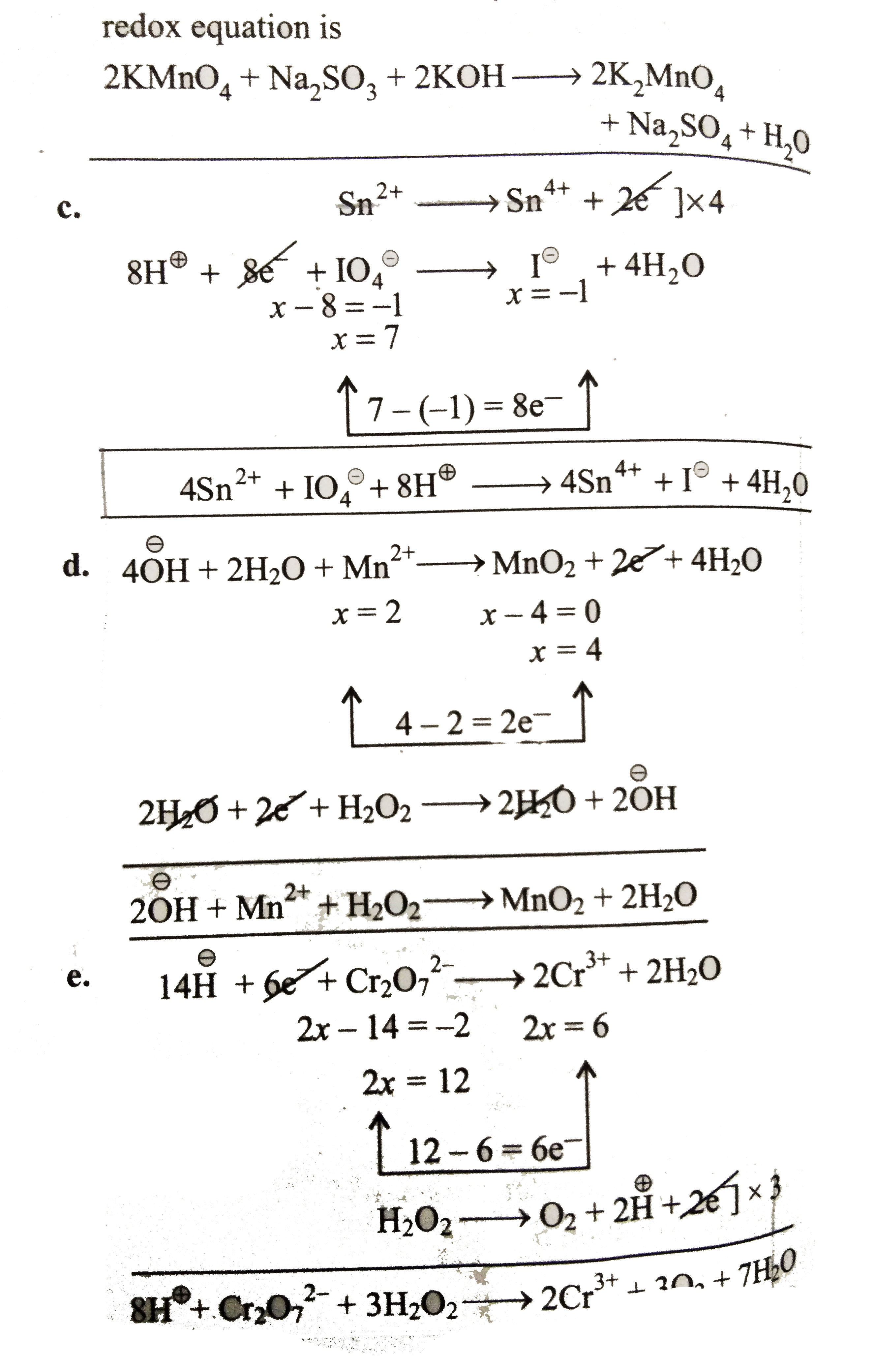Write balanced redox reactions for each of the following reactions:
(a) Potassium dichromate (K2Cr2O7) reacts with hydroiodic acid (HI) to produce potassium iodide, chromium (III) iodide, and solid iodine, I2(s).
(b) A purple solution of aqueous potassium permanganate (KMnO4) reacts with aqueous sodium sulphite (Na2SO3) in basic solution to yield the green magnanate ion (MnO2−4) and sulphate ion (SO2−4).
(c ) Sn2+(aq) reduce IӨ4(aq) to IӨ(aq) and is oxidised to Sn4+.
(d) H2O2(aq) oxidises Mn2+(aq) to MnO2 in basic medium.
(e) H2O2(aq) reduces Cr2O2−7(aq) to green coloured Cr3+(aq) in acidic medium.
The correct Answer is:A
(a) {:(Cr_(2)O_(7)^(2-)+cancel(6e^(-))+14H^(o+)rarr2Cr^(3+)+7H_(2)O),(2I^(ө)rarrI_(2)+cancel(2e^(-)]xx3),(ulbar(Cr_(2)O_(7)^(2-)+6I^(ө)+14H^(o+)rarr2Cr^(3+)+3I_(2)+7H_(2)O)):}
Add other ions to both sides, i.e.,
LHS[2K⊕81ө]RHS[2K⊕81ө]
The next redox equation is:
K2Cr2O7+14HI→2CrI3+3KI+3I2+7H2O
b. cancel(e^(-))+MnO_(4)^(ө)rarrMnO_(4)^(2-)]xx2
x−8=−1,x−8=−2
x=7,x=6
2overset(ө)OH+cancel(H_(2)O)+SO_(3)^(2-)rarrSO_(4)^(2-)+cancel(2e^(-))+cancel(2)H_(2)O
x−6=−2, x−8=−2
x=4,x=6
¯¯¯¯¯¯¯¯¯¯¯¯¯¯¯¯¯¯¯¯¯¯¯¯¯¯¯¯¯¯¯¯¯¯¯¯¯¯¯¯¯¯¯¯¯¯¯¯¯¯¯¯¯¯¯¯¯¯¯¯¯¯¯¯¯¯¯¯¯¯¯¯¯¯¯¯¯¯2MnOө4+SO2−3+2өOH→2MnO2−4+SO2−4+H2O––––––––––––––––––––––––––––––––––––––––––––––––––––
Adding other ions to both sides, i.e., 4K⊕,2Na⊕, the net redox equation is
2KMnO4+Na2SO3+2KOH→2K2MnO4+Na2SO4+H2O––––––––––––––––––––––––––––––––––––––––––––––––––
c. 
Topper's Solved these Questions
- REDOX REACTIONSBOOK - CENGAGE CHEMISTRY ENGLISHCHAPTER - REDOX REACTIONSEXERCISE - Exercise
29 Videos
- REDOX REACTIONSBOOK - CENGAGE CHEMISTRY ENGLISHCHAPTER - REDOX REACTIONSEXERCISE - Exercises (Linked Comprehension)
24 Videos
- REDOX REACTIONSBOOK - CENGAGE CHEMISTRY ENGLISHCHAPTER - REDOX REACTIONSEXERCISE - Ex 2.1
10 Videos
- PURIFICATION OF ORGANIC COMPOUNDS AND QUALITATIVE AND QUANTITATIVE ANALYSISBOOK - CENGAGE CHEMISTRY ENGLISHCHAPTER - PURIFICATION OF ORGANIC COMPOUNDS AND QUALITATIVE AND QUANTITATIVE ANALYSISEXERCISE - Assertion Reasoning Type
5 Videos
- S-BLOCK GROUP 1 - ALKALI METALSBOOK - CENGAGE CHEMISTRY ENGLISHCHAPTER - S-BLOCK GROUP 1 - ALKALI METALSEXERCISE - Archives Subjective
8 Videos
Similar Questions
In the following reactions:
a. 3MnO2+4Al→3Mn+2Al2O3
b. 2MnOө4+16H⊕+10Clө→2Mn2++5Cl2+8H2O
Which species is reduced and which is oxidised?
View SolutionConsider the following unbalanced redox reaction:
H2O+AX+BY→HA+OY+X2B
The oxidation number of X is −2 and niether X nor water is involved in the redox process.
The elements(s) undergoing oxidation is/are
View SolutionIdentify the oxidant and the reductant in the following reactions:
a. Zn(s)+12O2(g)→ZnO(s)
b. Zn(s)+2H⊕(aq)→Zn2+(aq)+H2(g)
View Solution(a). If both (A) and (R) are correct and (R) is the correct explanation for (A).
(b). If both (A) and (R) are correct and (R) is the correct explanation for (A).
(c). If (A) is correct and (R) is incorrect.
(d). If (A) is incorrect and (R) is correct. ltbr> (e). If both (A) and (R) are incorrect.
Q. Assertion (A): Essential oils are volatile and are isoluble in H2O
Reason (R): Essential oils are purified by steam ditillation.
View SolutionWhy can Solvay process not be used for the manufacture of potassium carbonate?
View SolutionWrite balanced redox reactions for each of the following reactions: (a) Potassium dichromate (K_(2)Cr_(2)O_(7)) reacts with hydroiodic acid (HI) to produce potassium iodide, chromium (III) iodide, and solid iodine, I_(2)(s) . (b) A purple solution of aqueous potassium permanganate (KMnO_(4)) reacts with aqueous sodium sulphite (Na_(2)SO_(3)) in basic solution to yield the green magnanate ion (MnO_(4)^(2-)) and sulphate ion (SO_(4)^(2-)) . (c ) Sn^(2+) (aq) reduce I_(4)^(Ө)(aq) to I^(Ө)(aq) and is oxidised to Sn^(4+) . (d) H_(2)O_(2)(aq) oxidises Mn^(2+)(aq) to MnO_(2) in basic medium. (e) H_(2)O_(2)(aq) reduces Cr_(2)O_(7)^(2-) (aq) to green coloured Cr^(3+)(aq) in acidic medium.
View SolutionBalance the following rebox reactions by ion electron method: a. MnO_(4)^(Θ)(aq)+I^(Θ)(aq) rarr MnO_(2)(s)+I_(2)(s) (in basic medium) b. MnO_(4)^(Θ)(aq)+SO_(2)(g) rarr Mn^(2+)(aq)+HSO_(4)^(Θ)(aq) (in acidic solution) c. H_(2)O_(2)(aq)+Fe^(2+)(aq) rarr Fe^(3+)(aq)+H_(2)O(l) (in acidic solution) d. Cr_(2)O_(7)^(2-)+SO_(2)(g) rarr Cr^(3+)(aq)+SO_(4)^(2-)(aq) (in acidic solution)
View SolutionBalance the net equtation fro th reaction of potassium dichromate (VI), K_(2) Cr_(2) O_(7) , with sodium sulphite, Na_(2)SO_(3) , in an acid solution to give chromium (III) ion and and sulphate ion. Strategy : Follow the seven -step proceduce , one step at a time.
View SolutionWrite the net ionic equation for the rection of potassium dichromate (VI) K_(2)Cr_(2)O_(7) with sodium suphite Na_(2)SO_(3) in acid solution to give chromium (III) ion and suphate ion
View SolutionBalance the following redox reactions by ion electron method:
a. MnOΘ4(aq)+IΘ(aq)→MnO2(s)+I2(s) (in basic medium)
b. MnOΘ4(aq)+SO2(g)→Mn2+(aq)+HSOΘ4(aq) (in acidic solution)
c. H2O2(aq)+Fe2+(aq)→Fe3+(aq)+H2O(l) (in acidic solution)
d. Cr2O2−7+SO2(g)→Cr3+(aq)+SO2−4(aq) (in acidic solution)
View SolutionWrite the net ionic equation for the rection of potassium dichromate (VI) K_(2)Cr_(2)O_(7) with sodium suphite Na_(2)SO_(3) in acid solution to give chromium (III) ion and suphate ion
View SolutionBalance the following redox reactions by ion electon mehtod (a) MnO_(4)^(-)+I^(-)(aq)rarrMnO_(2)(s)+I_(2) (in basic medium) (brgt (b) MnO_(4)^(-)(aq)+SO_(2)(g)rarrMn^(2+)(aq)+HSO_(4)^(-) (in acidic solution ) (c ) H_(2)O_(2)(aq)+Fe^(32+)(aq)rarrFe^(3+)(aq)+H_(2)O(l) (in acidic solution) (d) Cr_(2)O_(7)^(2-)(aq)+SO_(2)(g)rarrCr^(3+)(aq)+SO_(4)^(2-)(aq) (ion acidic solution)
View SolutionBalance the following redox reaction in basic medium by ion-electron method :
MnO−4(aq)+1−(aq)→MnO2(s)+12(s)
View SolutionBalance the following redox reactions by ion -electron method:
Cr2O2−7+SO2(g)→Cr3+(aq)+SO2−4(aq) (in acidic solution)
View SolutionWrite the net ionic equation for the reaction of potassium dichromate (VI), K_(2) Cr_(2) O_(7) with sodium sulphite, Na_(2)SO_(3) , in an acid solution to give chromium (III) ion and the sulphate ion.
View Solution
